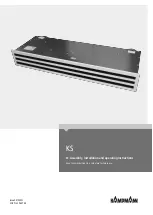
10
LIQUID PRESSURE
SATURATED LIQUID
TEMPERATURE °F
PSIG
R-410A
200
70
210
73
220
76
225
78
235
80
245
83
255
85
265
88
275
90
285
92
295
95
305
97
325
101
355
108
375
112
405
118
415
119
425
121
435
123
445
125
475
130
500
134
525
138
550
142
575
145
600
149
625
152
SATURATED LIQUID PRESSURE
TEMPERATURE CHART
Table 6
8 Condensate Drain Lines
The coil drain pan has a primary and a secondary drain
with 3/4” NPT female connections. The connectors required
are 3/4” NPT male, either PVC or metal pipe, and should
be hand tightened to a torque of no more than 37 in-lbs. to
prevent damage to the drain pan connection. An insertion
depth of approximately 3/8” to 1/2” (3-5 turns) should be
expected at this torque.
1. Ensure drain pan hole is not obstructed.
2. To prevent potential sweating and dripping on to
finished space, it may be necessary to insulate the
condensate drain line located inside the building. Use
Armaflex® or similar material.
A secondary condensate drain connection has been
provided for areas where the building codes require it.
Pitch all drain lines a minimum of 1/4” per foot to provide
free drainage. Provide required support to the drain line to
prevent bowing.
If the secondary drain line is required, run the line
separately from the primary drain and end it where
condensate discharge can be easily seen.
NOTE: Water coming from secondary line means the
coil primary drain is plugged and needs immediate
attention.
CAUTION
If secondary drain is not installed, the secondary access must
be plugged.
Insulate drain lines located inside the building or above
a finished living space to prevent sweating. Install a
condensate trap to ensure proper drainage.
NOTE: When units are installed above ceilings, or
in other locations where damage from condensate
overflow may occur, it is MANDATORY to install a field
fabricated auxiliary drain pan under the coil cabinet
enclosure.
The installation must include a “P” style trap that is located
as close as is practical to the evaporator coil. See Figure
12 for details of a typical condensate line “P” trap.
NOTE: Units operating in high static pressure
applications may require a deeper field constructed
“P” style trap than is shown in Figure 12 to allow
proper drainage and prevent condensate overflow.
Air Handler
2.75" MIN.
POSITIVE LIQUID
SEAL REQUIRED
AT TRAP
Drain
Connection
2" MIN.
Figure 11
NOTE: Trapped lines are required by many local
codes. In the absence of any prevailing local codes,
please refer to the requirements listed in the Uniform
Mechanical Building Code.
A drain trap in a draw-through application prevents air
from being drawn back through the drain line during fan
operation thus preventing condensate from draining, and
if connected to a sewer line to prevent sewer gases from
being drawn into the airstream during blower operation.
Use of a condensate removal pump is permitted when
necessary. This condensate pump should have provisions
for shutting off the control voltage should a blocked drain
occur. A trap must be installed between the unit and the
condensate pump.




































